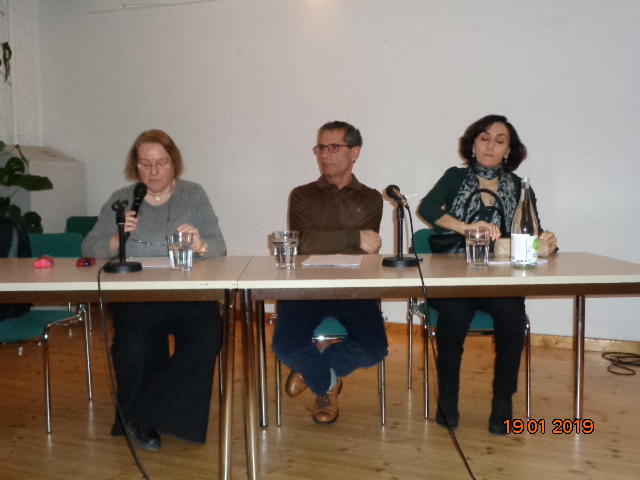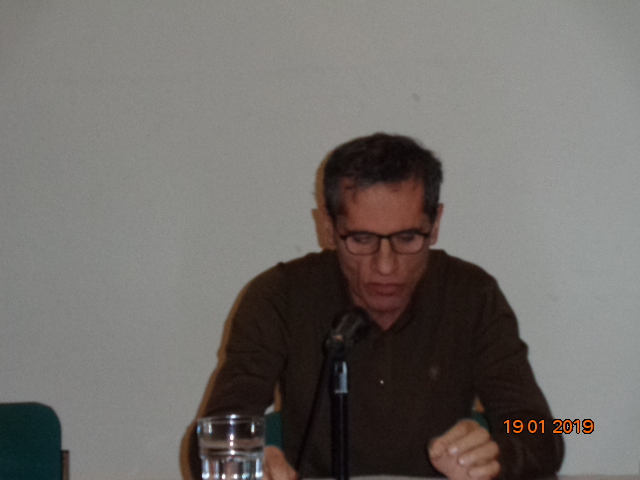Rediscovering Armenian Heritage in Turkey after Hrant Dink
Jan/26/2019 Archived in:Armenian Genocide | Turkey

From left, Tessa Hofmann, Miran P. Gültekin and Asa Tetik (translator),
by Muriel Mirak-Weissbach
BERLIN, JANUARY 24, 2019 — “The question of whether after such a complete elimination, after the almost total expulsion and forced expatriation of survivors in the successor state, the Republic of Turkey, an existence as an Armenian, subjectively and objectively, is at all possible, has been my concern as a human rights activist for decades.” This is how Tessa Hofmann, genocide researcher and chairwoman of the Arbeitsgruppe Anerkennung e.V (AGA: Working Group for Recognition; Against Genocide, for Understanding among Peoples), opened a commemorative event in Berlin on January 19, the 12th anniversary of the murder of Hrant Dink. This question was the theme addressed by the keynote speaker, Miran Gültekin, originally from Dersim and now living in Istanbul.
The event took place in the Democracy and Human Rights House in Berlin, and was attended by Armenians and Germans, members of the Dersim Cultural Community, the Berlin Armenian community, and representatives from the Armenian Embassy, among others.

Miran P. Gültekin
What Is an Armenian?
But before Gültekin developed the theme, drawing on his personal experience as a Turkish citizen of Armenian descent, Hofmann suggested it would be important first to ask what an Armenian identity really is. It is not an easy question to answer, since longstanding discrimination and persecution often lead to cultural, linguistic and religious assimilation, “what we sociologists call multiple or fluid identities,” she said.
To illustrate the concept, Hofmann drew on the book by Avedis Hadjian, Secret Nation: the Hidden Armenians in Turkey, which appeared last year. The lengthy study is based on interviews the author conducted with people who had at least one Armenian ancestor, who related their experiences in the period between 2011 and 2014.
First, the number of such people, “hidden” or “crypto-Armenians,” is not really known. If Jakob Künzler spoke of 132,000 Cristian orphans in 1919 and Johannes Lepsius estimated the Islamized Armenians that year amounted to 200,000, American archive records refer to 95,000 in 1921 throughout Anatolia. Author Hadjian reckons there were hundreds of thousands of Armenians forced to convert from 1915 on, with the aim of “de-Armenianizing” them. For generations they bore the stigma of being “converts,” “heathens” or “the uncircumcised.” For generations, they preserved the memory of the wrongdoings perpetrated, confiscation, theft, plundering and worse. Attempts later to regain stolen land and property were unsuccessful, defeating hopes of reorganizing as a community.
The interviews document a process of accommodation to the local majority populations, whether Arab or Kurd, Turkish or Zaza-Sunnite. And the resulting multiple identity could appear in one extended family, with ethnic Armenians alongside Syrian orthodox, or Sunni Muslims, some speaking Turkish, others speaking an Iranian dialect, and so forth.
The question of religion is key, given the role it has played in Armenian history, blending with ethnicity to constitute identity. Most Islamized Armenians, Hofmann reported, in Diyabakir and elsewhere, do not seek a return to Christianity, and the obstacles placed in the path of those who do are immense. The population of “hidden” Armenians is also politically diverse. Hofmann’s own view is that under such conditions “the descendants of Armenian genocide survivors in Turkey are far from constituting a nation or a reserve that can be retrieved to re-Armenianize Western Armenia, as some nationalists speculate.” Instead, they provide the “sad proof” of Raphael Lemkin’s definition of genocide, whereby the survivors are robbed of the possibility of belonging to the group that has been eliminated.
To Be an Armenian
Gültekin’s presentation was aptly titled, “Can One Be an Armenian in Turkey Today?” He estimates that there are 60,000 Armenians living in Turkey, mainly in the capital. From its founding, Turkey has denied and persecuted ethnic and religious diversity, targeting in particular non-Muslims. And even if there are no concrete attacks, “one cannot say that we are free to develop.”
In a historical review, he detailed what Armenian life looked like before 1915, with large communities, 20,000 in Dersim for example, who often constituted the majority population, as in his native Mazgirt; and they had their own schools and churches. In the genocide, Armenians could perhaps survive if they converted or went into hiding, especially concealing their identity. He gave his own family history as an example: “In Dersim everyone knew that we were Armenian, but none of us went to church. We had Turkish names and were Muslims…Alevites. This is a confession of Islam but not really accepted as such in Turkey and is mistrusted.” His father had given the children Turkish names and after his parents migrated to Germany, the rest of the family moved to Istanbul and took up residence in an Armenian neighborhood; but they still did not go to church or attend an Armenian school.
“Armenian identity is very closely associated with religion,” he confirmed, and “the idea that someone who is not a Christian cannot be an Armenian is very widespread.” Thus, there was no real access to the community, “it was impossible for Islamized Armenians to speak up with a loud voice and say they were Armenians.”
From Assassination to Rediscovery
All that changed dramatically with Hrant Dink’s murder, which ushered in a new era. “The 19th of January is the day on which, for me and other Armenians who had been forced to live as Muslims for years, this new era began.” He said they felt as though a family member had been killed; “the bullet hit precisely that place that we had been trying to hide and cover up in silence.” The habit of not talking about events was broken. “I went to the funeral and took part in the demonstrations,” he said. “Then I decided to change my name and went to the court. I changed my religion and became a Christian. I went to the Patriarchate of the Armenian Apostolic Church in Istanbul and was baptized.” The fact that his family stood by him was crucial, and wife, son, brother and even a 70-year-old uncle also were baptized.
The process was anything but easy. Many told him he had made a mistake, he became the target of threats and insults. Most shocking was the fact that he didn’t feel accepted in the Armenian — with the exception of the editorial board at Agos newspaper. Gültekin studied Armenian, travelled to Armenia and took language courses there, and over the years gradually has gradually become accepted as an Armenian, but still has never been able to assume leading positions in Armenian institutions.
Gültekin was convinced that it was not only a matter of identity but also a political question of his basic democratic rights. In fighting for one’s identity, it is not merely a matter of deciding to be an Armenian rather than a Kurd. Rather, it is cultural values that are fundamental. “We did not feel we belonged to Muslim culture,” he said; “there was a sense of emptiness.” In his attempt to reawaken an identity that had lain dormant, he started to talk about it. “I began to talk about what no one wanted to discuss. I told everyone. Journalists came from all over the world. Directors came. I told them all my life story.”
Out of this effort, he and his family and friends set up an association, which became a source of inspiration. Others followed their example, they had themselves baptized, went to church, celebrated Easter and so on. In Dersim they started Armenian language courses. In this process, many residents discovered their Armenian heritage, and it was often a traumatic experience.
“Imagine,” he said, “a child who has grown up in an environment where ‘Armenian’ is an insult, and then learns that his parents are Armenian. That is hard to accept. There are still people who cannot accept this. Their parents have become Armenians again, and go to church and the son goes to the mosque. Imagine such a situation, not only with respect to the religion but to the culture.”
The most important development was that their stories became known to a broader public, as books and documentaries appeared, the result of the work of hundreds of journalists who visited Dersim. This all happened, he said, at a time when Turkey “was still relatively democratic.”
Associations were formed, people began to commemorate the genocide, in Diyarbakir a church was reopened, Armenians let their identities be known. But in Dersim the situation is different. “Everyone there knows by now that we are Armenians,” he said, “But it is impossible to live there as an Armenian. There are neither churches nor can one speak Armenian in public.” Although they can purchase land, and attend Armenian schools that already exist, they cannot build new ones. So Istanbul remains the center of active Armenian life.
Gültekin stressed the subjective problems experienced by the community; in the current political climate, Armenians are under extreme emotional stress and often fear that persecutions could begin again at any time. Younger people want to emigrate and many researchers have abandoned their work due to the hostile atmosphere. Nonetheless Gültekin expressed his confidence in a better future and the hope that the next generations will have a happier life.
One crucial problem he described concerns the church. He said that many Armenians who have started to search for their relatives and their lost identities, have experienced difficulties when they try to get baptized. They are not always welcomed by the church representatives. As he put it, “anyone who has at least officially lived as a Muslim for many years cannot in their view enter the church.” For this reason often Armenians travel to Armenia or to Europe to be baptized.
In an exchange following the presentation, one Armenian asked what must have been on the minds of many others: “If even after a hundred years, repression and persecution continue, in an attempt to eliminate the Armenians, why don’t they simply leave Turkey?” Fundamentally, Gültekin replied, it is a fact that the Armenians, whether “hidden” or not, have their homeland there; that is where their ancestors lived and where their dead are buried. And they don’t want to give it up.
(Full texts of both speeches can be found at: http://www.aga-online.org/event/detail.php?locale=de&eventId=170.)

